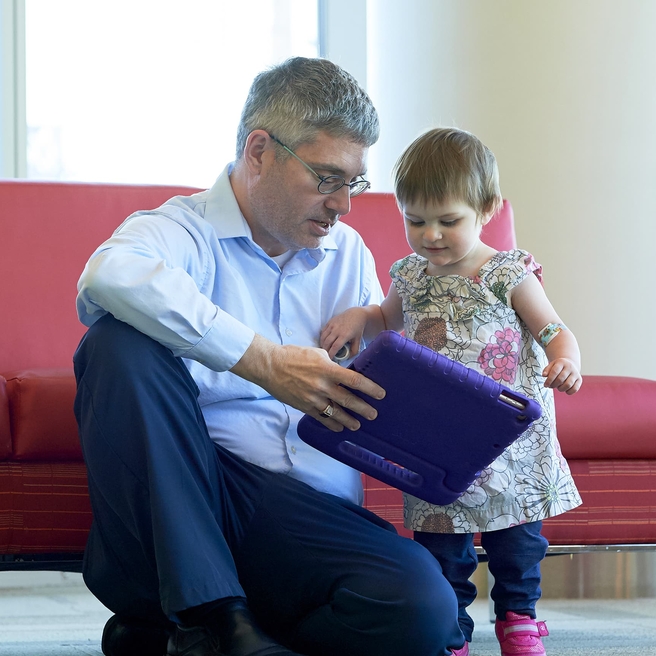What is Castleman Disease?
Castleman disease is a rare immune dysregulation disorder where an overgrowth of cells in your child’s lymph nodes causes them to be enlarged and sometimes also causes fevers or other signs of systemic inflammation (when the immune system is constantly defending the body). Lymph nodes are places where your immune system responds to infections. Enlarged lymph nodes due to Castleman disease are most often found in the neck, collarbone, underarm and groin areas.
There are two kinds of Castleman disease, and they are quite different. Castleman disease can affect a single lymph node. This is called unicentric Castleman disease, or UCD, and often causes no other symptoms. It can also affect multiple lymph nodes in different parts of the body. This is called multicentric Castleman disease, or MCD. Patients with MCD usually have lymph node swelling as well as flu-like symptoms (e.g. fever, weight loss, night sweats).
There are three types of multicentric Castleman disease.
- The first type of MCD is associated with a rare blood disorder called POEMS (Polyneuropathy, Organomegaly, Endocrinopathy, Monoclonal plasma cells, Skin changes) syndrome that can damage a child’s nerves and affect other parts of the body.
- The second type of MCD is associated with a virus called human herpes virus type 8 (HHV-8). It can sometimes also be associated with human immunodeficiency virus, or HIV. This is called HHV-8-associated MCD. T
- he third type of MCD has no known cause, but it is not due to infection from HHV-8. This is called idiopathic MCD (iMCD).
Causes of Castleman disease
We’re still figuring out what causes it; but our dedicated research teams are hard at work trying to find the answers. We do know that children with viruses like human herpes virus type 8 (HHV-8) or human immunodeficiency virus (HIV) can also become affected by Castleman disease.
Symptoms of Castleman disease
If your child has Castleman disease, you may notice symptoms like:
- Fever
- Unintended weight loss
- Fatigue
- Night sweats
- Raised lumps under the skin, especially in the neck, underarm, collarbone or groin area
Enlarged lymph nodes are a normal part of your child's response to infection and they are not permanent. If you notice lumps in your child’s neck, collarbone, underarm or groin area that are persistent, large, painful, or otherwise concerning, your child should see a doctor right away. This can be a sign of abnormally enlarged lymph nodes. More severe symptoms of Castleman disease can include flu-like symptoms, a feeling of fullness in the chest or abdomen that doesn’t go away, or an enlarged liver or spleen. Your child’s doctor can diagnose whether your child has these more serious symptoms.
Diagnosing Castleman disease
We know it can be confusing and scary when you cannot figure out why your child is sick, or you cannot find a treatment that works. The Immune Dysregulation Program here at Children's Hospital of Philadelphia (CHOP) provides a single place your family can turn to when your child is experiencing unexplained symptoms that affect multiple organs or symptoms that have not responded to treatment.
Our team will review your child’s medical history and do a detailed physical exam. We will also perform a variety of tests to help determine if your child has Castleman disease and to rule out other causes of enlarged lymph nodes, including:
- Blood and urine tests - These can reveal signs of inflammation, anemia, and other irregularities in your child’s blood. These tests can also help rule out infections or diseases since symptoms of Castleman disease can be similar to other disorders that affect the immune system.
- Imaging tests - A CT scan or PET scan can look for enlarged lymph nodes, liver, or spleen. A PET scan can also determine if any previous treatments your child had are working.
- A lymph node biopsy – This is where a tissue sample is removed from your child’s lymph node and examined in our laboratory. We can then determine if your child has Castleman disease or another type of disorder, like infection or lymphoma.
Treatment for Castleman disease
Our program includes experts in many medical specialties throughout CHOP. We can work with them as necessary to treat your child. After using state-of-the-art testing to diagnose your child, we will work with you to create a personalized treatment plan. Treatment will vary depending on which type of Castleman disease your child has.
If your child is diagnosed with unicentric Castleman disease (UCD), we can treat them by surgically removing the lymph node that is affected or using medicine to shrink the lymph node.
If your child is diagnosed with multicentric Castleman disease (MCD), treatment can include:
- Regularly prescribed medications, such as immunotherapy drugs like siltuximab, rituximab, or rapamycin. This will help stop your child’s body from making too much of the protein found in people who have MCD.
- Regularly prescribed medications like glucocorticoids (often called “steroids”), like prednisone. This will help control inflammation in your child’s body.
- Chemotherapy describes powerful medicines that can help slow the overgrowth of cells in your child’s lymph nodes. This may be needed if your child’s symptoms do not respond to immunotherapy.
- If your child has HHV-8-associated MCD, antiviral drugs can be used to block the activity of one or both viruses.
Follow up care and long-term outcomes
Children with unicentric Castleman disease usually do well once the affected lymph node is removed. Your child will need follow-up exams, including imaging, to make sure they remain healthy.
Multicentric Castleman disease can be life-threatening and lead to severe infections or organ failure. Children who also have HIV may experience serious complications. Our team at CHOP will work together to determine the treatment that will result in your child’s best possible health.
